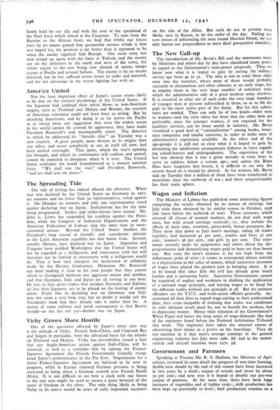Wages and Inflation
The Ministry of Labour has published some interesting figures comparing the results obtained by its census of earnings last July with those obtained by its similar census in October, 1938 (the latest before the outbreak of war). These censuses, which covered all classes of manual workers, do not deal with wage rates, but with actual earnings received ; i.e., they include the effects of short time, overtime, piece-work, bonus payments, &c. They show that down to July men's earnings, taking all trades together, had increased 42 per cent., youths and boys 57 per cent., women's 36 per cent., and girls 35 per cent. The state- ments recently made by magistrates and others about the dis- proportionate and demoralising wages paid to boys are thus borne out. But even the men's increase is far too high from the inflationary point of view ; it seems to correspond almost entirely to a depreciation in the value of money, which successive increases of wages have played the greatest part in bringing about. It is to be feared that since July the evil has already gone much further and is increasing faster. Successive Governments cannot be acquitted of neglect and weakness in shirking the application of a national wage principle, and leaving wages to be fixed for the different trades without any principle at all. But the primary offenders are the T.U.C. and trade-union officials generally. Ac- customed all their lives to regard wage-raising as their professional duty, they seem incapable of realising that under war conditions its only ultimate result must be, not to benefit the workers, but to depreciate money. Hence their rejection of the Government's White Paper and hence the long series of wage-demands like that of the engineers heard before the National Arbitration Tribunal this week. The engineers have taken the unusual course of advertising their claims in a poster on the hoardings. They do not mention in it that men's average earnings in the general engineering industry last July were 1o6s. 8d. and in the motor- vehicle and aircraft factories were 127s. 5d.


























 Previous page
Previous page